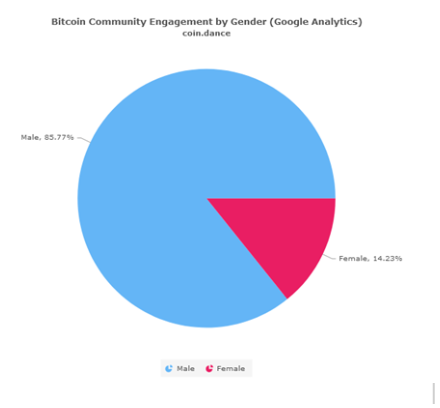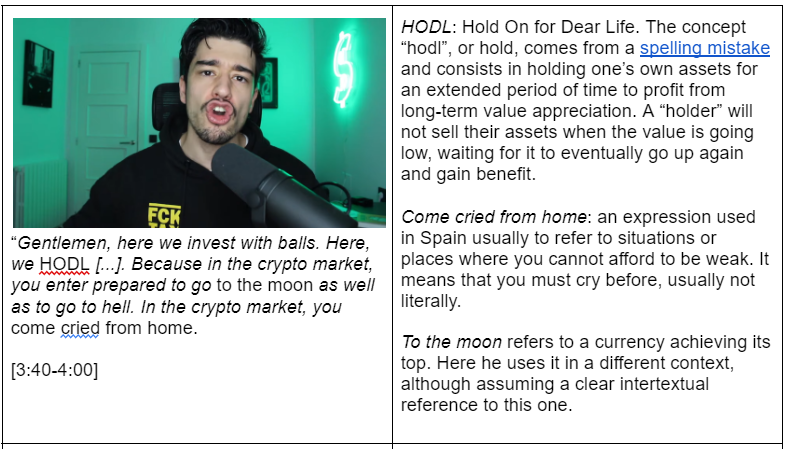
“Gentlemen, Here We Invest With Balls”: Cryptos and the Celebration of Unfettered Hegemonic Masculinity
In the last 10 years, the financial world has been 'infected' with cryptocurrencies, which have also attracted many investors. An exciting, innovative and digitally native project. It seems the perfect scenario to change things. But nothing beyond reality. The online world, of course, does not escape the problems of the offline world. One such problem has to do with displays of masculinity in the financial world, concerning crypto coins and the culture of so-called 'crypto bros'.
Urban Dictionary defines “crypto bros” as “people [although typically male] with a weak grasp on cryptocurrencies/blockchain”, who claim to have the 'best' opinions about them. The reason they have been categorized as an entire subculture is because of their methods, which utilize exceeding displays of masculinity in order to gain more followers and investors for some of the coins they might be promoting.
Economics has always been a male-dominated field (Dolar, 2022). One of the most popularized displays of masculinity in the field of economics is shown in the biographical comedy movie portraying the life of Jordan Belfort, The Wolf of Wall Street. Jordan Belfort, played by actor Leonardo DiCaprio, displays hegemonic masculinity traits through gratuitous aggressiveness, drug and alcohol abuse and sexist, misogynistic actions. His wife, Naomi, played by famous actress Margot Robbie, exists as a trophy wife to boast about what he has gained from the world of finance.
According to Mark Steven, the main character portrays a certain type of masculinity where he is psychically damaged and socially isolated, yet powerful (Steven, 2019). He also does not see that he is abusing drugs to mask what he is hiding under his unusual toxic masculine behavior. However, many people seem to have misunderstood the purpose of the film and have taken it as an example to follow, as a goal.
Now that Mr. Belfort has gotten into cryptocurrencies in real life, hosting hangouts with his new crypto buddies at his 'humble abode', he still continues to have an influence in this new financial world. He wants to battle the male dominance in the crypto world, as he puts it, but then says: “We got to get some girls in here next year”. “Women”, he corrects instantly in a New York Times interview. The instinct to call female colleagues "girls' seems questionable to say the least. Misogyny seems to have become a norm in this world.
This paper will analyze various texts from social media concerning the displays of hegemonic masculinity in the world of crypto. Through the analysis in this paper, we will explain the subculture created by crypto bros and how they have created an ideology based on displays of masculinity linked to the bravery and less risk-averse behaviour associated with crypto bros.
Crisis and hegemonic masculinity
Let us first stop to understand the hegemonic masculinity that has existed in the offline world since the beginnings of society. Qualities and attributes generally considered as characteristics of men are called masculinity. These roles, behaviors and attributes are what is socially considered appropriate for boys and men. Some men are unable to define their place in the changing society and that inability has become a crisis according to some people: “the crisis of masculinity”. The term was developed in the late 1960s, and it was then described as “the nervous concerns that middle-class men had regarding masculinity and the male body during the late nineteenth and early twentieth century” (Taister, 1995, p. 1).
During the Second World War, many women took over the roles traditionally held by men while they were off serving in the millitary. Traditional masculine roles such as a provider and a protector were taken over by women. Gender roles became blurry, fueling the idea of “a crisis in masculinity”. The idea of a crisis raised questions about the changing cultural role of the man. It is a situation in which the traditional cultural touchstones of masculinity were under real or perceived threat, of men struggling to adjust to a world in which they have been outcompeted academically by women, and of so-called “blue collar” jobs, once largely held by men, being displaced. British sociologist John MacInnes once put it: “Masculinity has always been in one crisis or another” (MacInnes, 1998, p. 11).
Feminism and the crisis of masculinity
In the last sixty years, women started to infiltrate layers of society that were traditionally only inhabited by men. Traits traditionally viewed as masculine such as independence and leadership were also beginning to be taken by women, which fueled the idea of a crisis of masculinity even further. Men started to resist the waves of feminism and they wanted to maintain their previous place in society. A study by Jennifer Lemon concluded it by saying: “the rise of feminism and the women's movement, and the gay liberation movement have contributed substantially to the emergence of the contemporary 'crisis of masculinity', disrupting the assumptions of patriarchal ideology and hegemonic masculinity” (Lemon, 2011).
Hegemonic masculinity traits in the crypto project
The cryptocurrency industry is “deeply entwined with masculinity, especially the norm of the entrepreneurial, tech-savvy male investor/developer” (Henshaw, 2022, p. 10). This market is “at best, characterized by a “bro culture” and, at worst, dominated by sexual harassment and exclusionary practices” (Henshaw, 2022, p. 10). If we look at the numbers, we can see that 86% of the Bitcoin community are men, based on the Bitcoin statistics service Coin Dance.

Figure 1: Bitcoin Community Engagement by Gender
So far, nothing new. Finance has always been seen as a male-dominated industry. The reason is straightforward: reproductive labor is essential to capitalist accumulation and has historically been exercised by women (Federici, 2021), which leaves productive labor and the public sphere to men as they are believed to be the ones empowered to do so. Finance and economics serve as a stage for discourses on masculinity, where power and privilege for men are reproduced. Various features of paternalistic and competitive masculinity can be detected with a certain ease in these areas (Kerfoot & Knights, 2007).
However, we argue that, for several reasons, gender inequalities take on a different dimension and intensity in the crypto market. First and foremost, the crypto and blockchain project is marketed as an alternative, a rebellion, and an economic democracy. It is indeed an alternative, but the notion that the unregulated nature of crypto finance, and thus the decentralization of the currency, results in the decentralization of the power can be considered a “fallacy” (Ortiz, 2022). This is because the issue is not with the “dollars or the central bank but rather the economic system, the structure and the market dynamics in which this money operates” (Ortiz, 2022).
Second, because it is a digital project it inevitably intertwines with digital languages, ideologies and channels. This explains why the project's voice is being led by young people, and why there are many Reddit threats, memes, and a specific digital language. As the rich literature written around digital discourse brings to light, these discourse practices are inherently ideological, “as they articulate particular sets of ideas, perceptions, or received wisdom and, at the same time, they are organized, modulated and reproduced within power-regulating institutional environments, such as the media or the state” (Spilioti, 2015). That different context demands a different approach - digital discourse analysis.
Spanish YouTuber Wall Street Wolverine
Víctor Domínguez, mostly known as Wall Street Wolverine, is a popular Spanish YouTuber with half a million subscribers who talks on his channel about economic and political actuality with a focus on cryptocurrencies. Without even watching a video, we can get an idea of what he proposes and what appeals to him in relation to his audience by taking a look at his most popular streams. Among his most streamed videos, we can see headings such as “THIS IS CUBA” or “HOW MUCH MONEY DO I EARN?”, as well as a Ferrari, women in a sexualized pose and videos about the Spanish far-right party Vox.

Figure 2. Most popular videos of Wall Street Wolverine
Wall Street Wolverine started as a fitness YouTuber, named Invicthor, a channel still active but with more lifestyle-oriented topics and not much attention. In his popular channel, he has no shame when it comes to expressing his views and discussing any topics, but in the past two years, he has taken a turn to cryptocurrencies. He is also active on other social platforms such as Instagram, Twitch and Telegram, and has his own merchandising with slogans such as LIBERTARIAN IS THE NEW PUNK or JUST HODL.
Video analysis: a motivational speech
Wall Street Wolverine uploaded a video to his channel following the cryptocurrency crash in May 2021 as a result of Elon Musk's announcement that Tesla would stop accepting Bitcoin payments due to environmental concerns, the US Department of Justice's investigation into Finance for money laundering, and the People's Bank of China's reiteration that digital currencies cannot be used for payments in China. In this video, the YouTuber wears a shirt with “FCK TAX” slogam reporting on the situation and expressing his opinion. The video ended up being a sort of motivational' speech accompanied by grandiose Interstellar-like background music, a commanding tone, screaming, and numerous insults. After minute 3:25, one can see how this develops. “This is a message for the holders”, he starts.
In the following table, you can find the transcription in English of the most representative moments of the video, together with some screenshots. Next to the screenshots, we have summarized the discourse utilized by Wall Street Wolverine in order to fully understand his perspective on the Bank of China's reiteration of digital currencies. These screenshots, transcripts and explanations of parts within the video were carefully discerned as they provide valuable insights into the discourse surrounding crypto and hegemonic masculinity. These moments effectively showcase how language, cultural references, body language and metaphors collectively contribute to the construction of a specific masculine identity within the crypto community. By utilizing these moments specifically, our analysis would ultimately be more broad and reinforced.



According to discourse analysis, language is never neutral. In Wall Street Wolverine’s video, this is especially pertinent. The YouTuber responds to a prevalent aspect of hegemonic masculinity in the video by speaking in an angry and forceful manner. With expressions like “here we invest with balls” or “you come cried from home”, he expresses that there is no room for weakness and hesitation in the “fiercest market in history”.
The concept “HODL” or “hold” puts everything together. To hold it is also a proof of belonging, of strength. In the video, he explicitly refers to the ‘holders’ and encourages those who are not to close the video. Here, then, to hold works as a social rule, that delivers a very specific ideology and way to approach the world. He pushes an aspirational lifestyle to his network of insiders that rhymes with his former fitness influencer personality. It is all about infinite improvement throughout the life cycle, whether through physical improvement or economic gain.
Not holding, then, is shown as something weak. And it is necessary to be strong to be considered an ‘insider’. In this case, the idea of an ‘outsider’ (Becker, 1963) is not built in opposition to the rest of society, but by reinforcing their own personality among themselves. Thus, deviance is assessed by strength and weakness. What is more, the decision to use terms such as “balls” and “jerk off” delivers an explicit link to hegemonic masculinity, as it implies that the lack of these characteristics excludes you as eligible to be a 'real man'.
Additionally, as we previously discussed, some people view cryptocurrency as a rebellious and defiant project. In this case, we can see a clear rejection of the idea of a bank investor, around which this idea is built. Wall Street Wolverine targets investors as weak because he considers the stock market (a regulated sector in line with the institutions they reject) to be safer and less courageous. Bank investors lack the “balls” to enter the crypto market.
Apart from that, some of the crypto influencers aesthetic preferences also exhibit traits of hegemonic masculinity. It is quite common to see expensive cars, especially on TikTok, when talking about cryptos, with a clear reminiscence to the golden era of hip-hop, and as it continues in the current trap-era of hip-hop music.
Thus, status linked to consumerism and opulenceserves also as a social rule. Firstly, because it represents a goal for newcomers, a discourse that works perfectly under neoliberalism since its subject subscribes to be “an entrepreneur of every aspect of their life” (Nguyen, 2016). And secondly, it works as a hegemonic masculinity feature in relation to the first reason since it represents a way of social acting linked to the public sphere.
Thus, status linked to consumerism and opulence serves as a social rule.
Cryptocurrency and the crisis of masculinity
The crypto market is populated by men who embrace the traditional, hegemonic, masculine traits, such as strength, courage, independence, leadership, risk-taking, not showing emotion, and confidence. In the discourse analysis we did on the Youtuber Wall Street Wolverine we can clearly see this. He completely fits the 'crypto bro' stereotype. He channels all of these masculine traits and shares them with his half million subscribers. An audience who praises him and eats everything he says or does.
For these men, cryptocurrency has become a new way of asserting their dominance and beholding their masculinity by gaining more money, power and status. Rohitha Naraharisetty said that “there is a very specific energy to the shapers of finance culture: a frenetic coked-up energy of Wall Street is the aspirational vibe – the dominance, aggression, control, and fearlessness are seductive” (Naraharisetty, 2022).
Our analysis unveiled how the premise of the cryptocurrency community can be misleading: although the digital nature of this type of currency has a democratic hue that allows different types of people to participate in it, the ground rules that guide belonging and exclusion within this group remain deeply rooted in a male-dominated, 'Wall Street' type of culture.
Although some research has shown that women tend to be more risk and los averse than men when it comes to financial decision-making (Charness & Greenzy, 2012) and this could explain in part why there are fewer women in this context, it is of no doubt that the type of discourse and communication used inside the online crypto communities tends to be overly sexist and unwelcoming for minority groups in general.
Crypto-bros empower themself by adopting a whoblack-and-white' polarized view of the world: there are the weak members of society who always go for the safe option and then there are the true men who can take risks and become powerful and rich. The crypto market is an extremely dynamic and volatile world where people should not invest if they cannot afford to lose something. Because of this reality, crypto-bros use expressions that elicit dangerous scenarios and show that they are ready for risk in this crazy market: they are like 'sharks going after blood'. The underwater, shark and blood imagery is also commonly used in the financial Wall Street world (for example, popular Shark Tank TV show), and this is how it is used by the analyzed YouTuber.
The community is also structured in a hierarchical way that positions at the top the 'big sharks' of finance like Jordan Belfort. These figures are admired because of their way of life more than their actual knowledge of financial matters, even though the web is populated with many 'how to' videos. Nonetheless, personal beliefs and lifestyles are sometimes worth more than factual knowledge.
The values brought forward by the community respond to a set list of characteristics that are not limited by the use of language and generally aggressive tones, but that also include, for example, background music chosen for videos or the merchandise worn and sold by content creators. Many of these markers of identity also point towards a specific political orientation as well, often used as a vehicle for selling merchandise as well.
In a time where gender roles are slowly shifting, this way of thinking allows the ingroup to feel reassured about their role as 'real men' by excluding everyone who does not fit their stereotyped ideal of what that means.
The Verdict
Cryptocurrencies therefore represent a safe field for the unraveling of hegemonic masculinity. Since business, economics and technology are already primarily male-dominated fields, filled with institutionalized sexism and hegemonic masculinity, it is of no surprise that the rise of a new system that combines these fields would foster the same type of environment and ways of thinking. The world of cryptocurrency is a space where the types of behaviour we have talked about are taken from the economic realm and shifted to an online field, an even less regulated one. Here these ways of acting are not only accepted but supported and encouraged. It is this deregulated and fierce context and the intertextuality of the language they use that we argue generates this ideal space for the unfolding and celebration of unfettered hegemonic masculinity.
References
Adams, R. S. (2022, March 10). 6 reasons why there aren’t more women in crypto. Bankless.
Bhatt, G. (2022, September 1). Reimagining Money in the Age of Crypto and Central Bank Digital Currency. IMF.
Carroll, B. E. (2019, May 17). Crisis of Masculinity. American Masculinities: A Historical Encyclopedia.
Charness, G., & Gneezy, U. (2007, September 18). Strong Evidence for Gender Differences in Investment. SSRN Electronic Journal.
Chen, J. (n.d.). Gender Differences in Risk Taking: Are Women more Risk Averse?
Diggit Magazine. (2022, July 20). Discourse. Retrieved November 28, 2022.
Dolar, V. (2022, November 16). The gender gap in economics is huge – it's even worse than Tech. The Conversation.
Estela Ortiz. (2021, December 5). CRIPTOMONEDAS y Masculinidad [Video]. YouTube.
Estela Ortiz. (2022, May 19). La Ideología de las CRIPTOMONEDAS o por qué las crypto no desafían el sistema [Video]. YouTube.
Fairclough, N. (1992). Intertextuality in critical discourse analysis. Linguistics and Education, Volume 4, Issues 3–4, pp. 269-293, ISSN 0898-5898.
Federici, S. (2021). Patriarchy of the Wage: Notes on Marx, Gender, and Feminism (Spectre) (None). PM Press.
García, J. (2021, May 20). “HODL” o cómo una falta de ortografía acabó siendo uno de los lemas (y memes) más populares del mundo del mundo de las criptomonedas. Xataka.
Investopedia. (2022, July 18). HODL: The Cryptocurrency Strategy of “Hold on for Dear Life” Explained. Investopedia.
Kerfoot, D., & Knights, D. (1993). MANAGEMENT, MASCULINITY AND MANIPULATION: FROM PATERNALISM TO CORPORATE STRATEGY IN FINANCIAL SERVICES IN BRITAIN*. Journal of Management Studies, 30(4), 659–677.
Kimmel, M. S. (2018, October 24). The Contemporary “Crisis” of Masculinity in Historical Perspective | 8. Taylor & Francis.
Lemon, J. (1992). The crisis of masculinity and the renegotiation of power. Semantic Scholar.
MacInnes, J. (1998). End of masculinity: The confusion of sexual genesis and sexual difference in modern society. McGraw-Hill Education (UK).
Naraharisetty, R. (2022, April 7). How Crypto ‘Bro’ Culture Around Finance Is the New Toxic Masculinity. The Swaddle.
Naraharisetty, R. (2022, April 27). Blockchain Ideology Is Rooted in Exclusion. A Feminist Lens Shows Why. The Swaddle.
Nguyen, Kim. (2016). Rhetoric in Neoliberalism. In Rhetoric and Neoliberalism, ed. Kim Nguyen, 1–14. New York: Palgrave Macmillan.
ReGain Editorial Team. (2022, October 11). What Is The Crisis Of Masculinity? Regain.
Rnz. (2021, May 30). The money craze that rises and collapses on a tweet. RNZ. Retrieved November 30, 2022.
Steven, M. (2019). Cinematic Masculinity in the Age of Finance. Postmodern Culture, 30(1).
Spilioti, T. (2015). Digital discourses. In The Routledge Handbook of Language and Digital Communication (pp. 133-151). Routledge.
The Detail, RNZ. (2021, May 28). The strange (and sexist) language of cryptocurrency.
Tulberg, M. (2013). Masculinity in the Financial Sector. Oxford Handbooks Online.
Wall Street Wolverine. (2021, May 19). BITCOIN SE HUNDE 🤦🏻♂️ LA GRAN CAÍDA de 2021 [Video]. YouTube.
Yaffe-bellany, D. (2022, April 15). The Wolf of Crypto. The New York Times. Retrieved November 30, 2022.